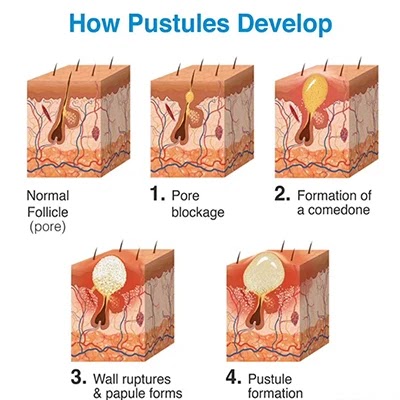Pustules Acne Causes , Symptoms, and Treatment
Pustules Acne Causes , Symptoms, and Treatment
Red pimples with a white or yellow center
Pustules acne is a common skin condition characterized by raised, inflamed bumps on the surface of the skin. These bumps are usually filled with pus and can be sensitive to touch. Pustules acne can occur on any part of the body, but it is most commonly found on the face, chest, and back.
The development of pustules acne is the result of several factors, including excessive oil production, clogged pores, bacterial infections, and inflammation. Hormonal imbalances and certain medications may also contribute to the condition.
Symptoms of pustules acne can vary in severity, but they are typically identified by the presence of raised bumps filled with pus on the skin's surface. These bumps may appear swollen, red, and painful. In severe cases, pustules acne can lead to permanent skin damage and scarring.
Various treatment options are available for pustules acne, including both over-the-counter and prescription medications. Topical treatments like benzoyl peroxide and salicylic acid can help reduce inflammation and unclog pores. Oral antibiotics or stronger topical medications may be necessary for more severe cases.
Preventative measures for pustules acne include regular skin cleansing and exfoliation, avoiding touching the face with dirty hands, and refraining from using harsh skincare products that may irritate the skin. Maintaining a healthy diet and managing stress levels may also help prevent pustules acne.
While pustules acne can be a frustrating and painful condition, proper treatment and preventative measures can effectively manage it.
What causes Pustule Acne To appear on the human body ?
Pustule acne is a specific type of acne that occurs when hair follicles become blocked with dead skin cells, bacteria, and oil. This accumulation of substances leads to the formation of a raised, red bump on the skin that contains pus.
Numerous factors can contribute to the emergence of pustule acne, including hormonal changes that occur during puberty, menstruation, or pregnancy that increase oil production in the skin, as well as genetic predisposition, where if a person's parents or siblings have had acne, they may also develop it. Moreover, the bacteria Propionibacterium acnes (P. acnes) that resides on the skin can also contribute to acne formation, as well as inflammatory factors in the skin.
Poor skincare habits, such as using harsh products or neglecting to wash your face regularly, or not removing makeup before bed can also contribute to the development of acne.
It is important to recognize that various factors may cause pustule acne, and the trigger for one person may differ from another. In cases of persistent or severe acne, seeking the advice of a Dermatologist for customized treatment and guidance is advisable.
Here are some tips to prevent and manage Pustule Acne :
Pustule acne is a prevalent form of acne that is characterized by red, irritated bumps on the skin that are filled with pus. To prevent and manage pustule acne, there are several tips to follow:
Firstly, it is essential to keep your skin clean by washing your face twice a day with a gentle cleanser to remove excess oil, dirt, and sweat. Secondly, avoid picking or squeezing pimples as this can cause the bacteria to spread, resulting in more inflammation and worsening of acne.
It is also important to use non-comedogenic products, which do not clog your pores, and to manage stress through exercise, meditation, or other stress-reducing techniques, as stress can trigger acne breakouts. Moreover, avoid touching your face as this can transfer bacteria and oil from your hands to your skin, leading to acne.
Over-the-counter acne treatments containing benzoyl peroxide, salicylic acid, or alpha hydroxy acids can be used to reduce inflammation and unclog pores. However, if your acne is severe or not responding to over-the-counter treatments, it is advisable to consult a Dermatologist who can prescribe stronger medications, such as topical retinoids or oral antibiotics.
Pustule Acne Treatment :
Pustule acne is a form of acne characterized by small, pus-filled bumps on the skin, and it's essential to seek treatment to prevent further breakouts and scarring. Below are some of the most effective treatments for pustule acne:
Topical Benzoyl Peroxide: This treatment is highly effective against pustule acne since it eliminates the bacteria responsible for acne, reduces inflammation, and unclogs pores. You can easily find benzoyl peroxide in many over-the-counter acne treatments.
Salicylic Acid: Salicylic acid is another excellent treatment for pustule acne, as it unclogs pores and exfoliates the skin. It is present in several over-the-counter acne treatments, including cleansers and spot treatments.
Topical Retinoids: These are vitamin A derivatives that regulate skin cell turnover and reduce inflammation. While topical retinoids can treat pustule acne, they can irritate the skin, so it's best to start with a low concentration and gradually increase it over time.
Antibiotics: Dermatologists may prescribe antibiotics to manage severe or persistent pustule acne cases. Antibiotics work by killing acne-causing bacteria and reducing inflammation.
Blue Light Therapy: This non-invasive treatment uses light to kill acne-causing bacteria and can be effective in treating pustule acne, although it may require multiple treatments.
It's important to note that each person's skin is unique, and what works for one may not work for another. Therefore, consulting with a Dermatologist is always recommended to determine the best treatment plan for individual needs.



